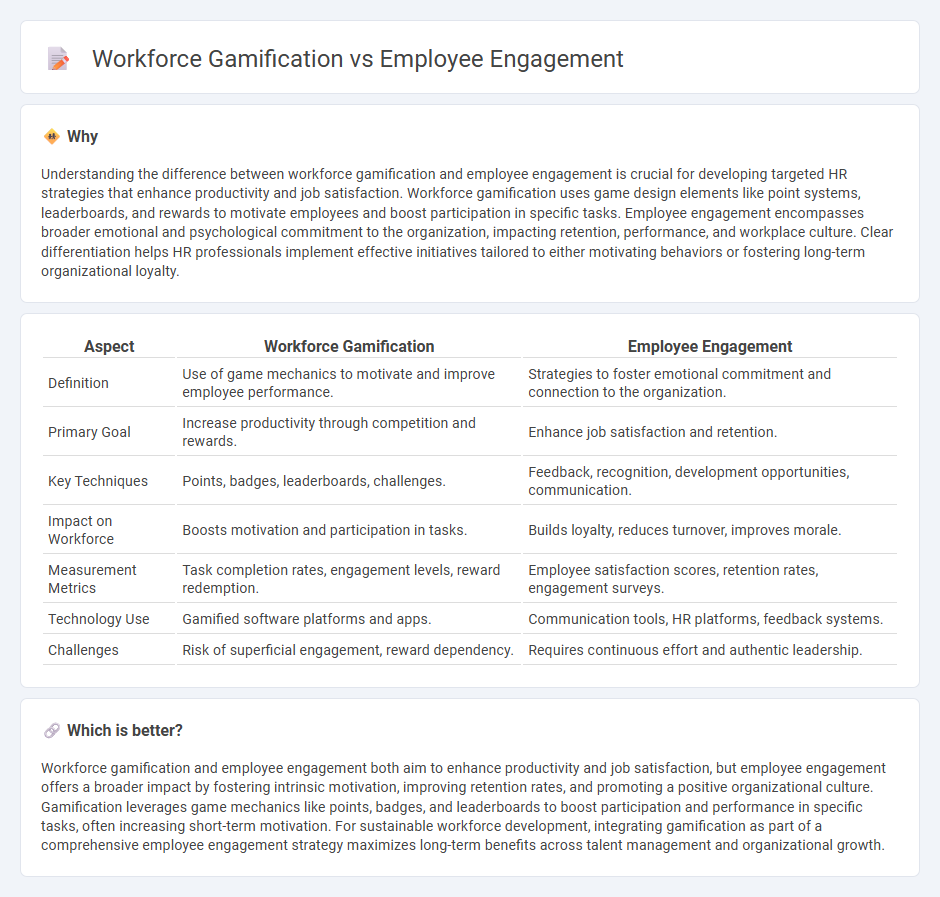
Workforce gamification leverages game mechanics to motivate employees, enhancing productivity and collaboration through rewards and challenges. Employee engagement focuses on fostering a committed and motivated workforce by aligning individual goals with company values and culture. Explore how integrating gamification strategies can significantly boost employee engagement and business performance.
Why it is important
Understanding the difference between workforce gamification and employee engagement is crucial for developing targeted HR strategies that enhance productivity and job satisfaction. Workforce gamification uses game design elements like point systems, leaderboards, and rewards to motivate employees and boost participation in specific tasks. Employee engagement encompasses broader emotional and psychological commitment to the organization, impacting retention, performance, and workplace culture. Clear differentiation helps HR professionals implement effective initiatives tailored to either motivating behaviors or fostering long-term organizational loyalty.
Comparison Table
| Aspect | Workforce Gamification | Employee Engagement |
|---|---|---|
| Definition | Use of game mechanics to motivate and improve employee performance. | Strategies to foster emotional commitment and connection to the organization. |
| Primary Goal | Increase productivity through competition and rewards. | Enhance job satisfaction and retention. |
| Key Techniques | Points, badges, leaderboards, challenges. | Feedback, recognition, development opportunities, communication. |
| Impact on Workforce | Boosts motivation and participation in tasks. | Builds loyalty, reduces turnover, improves morale. |
| Measurement Metrics | Task completion rates, engagement levels, reward redemption. | Employee satisfaction scores, retention rates, engagement surveys. |
| Technology Use | Gamified software platforms and apps. | Communication tools, HR platforms, feedback systems. |
| Challenges | Risk of superficial engagement, reward dependency. | Requires continuous effort and authentic leadership. |
Which is better?
Workforce gamification and employee engagement both aim to enhance productivity and job satisfaction, but employee engagement offers a broader impact by fostering intrinsic motivation, improving retention rates, and promoting a positive organizational culture. Gamification leverages game mechanics like points, badges, and leaderboards to boost participation and performance in specific tasks, often increasing short-term motivation. For sustainable workforce development, integrating gamification as part of a comprehensive employee engagement strategy maximizes long-term benefits across talent management and organizational growth.
Connection
Workforce gamification leverages game mechanics to enhance employee engagement by making tasks more interactive and rewarding, which boosts motivation and productivity. Engaged employees demonstrate higher commitment, improved collaboration, and greater job satisfaction, directly impacting organizational performance. Implementing gamification strategies in human resources fosters a dynamic work environment that strengthens employee retention and talent development.
Key Terms
Motivation
Employee engagement drives motivation by fostering purpose and alignment with company goals, enhancing productivity and satisfaction. Workforce gamification leverages game mechanics like rewards, challenges, and leaderboards to boost motivation, engagement, and competition in daily tasks. Explore how integrating these strategies can maximize workforce motivation and overall performance.
Recognition
Employee engagement through recognition enhances motivation by acknowledging individual and team achievements, fostering a positive workplace culture. Workforce gamification incorporates game mechanics like points and badges to make recognition more interactive, driving sustained participation and collaboration among employees. Discover how integrating these strategies can transform employee motivation and boost organizational performance.
Participation
Employee engagement measures overall commitment and emotional investment in the workplace, while workforce gamification specifically uses game mechanics to boost participation and motivation. Gamification strategies often lead to higher interaction rates through points, leaderboards, and rewards, driving active involvement in tasks and training sessions. Explore detailed insights on how these approaches impact participation metrics and enhance organizational performance.
Source and External Links
Why employee engagement is key to company success - Employee engagement boosts productivity by 18%, increases profitability by 23%, and significantly reduces absenteeism when employees feel valued and connected through personalized communication and recognition.
How to Improve Employee Engagement in the Workplace - Highly engaged teams show 14-18% higher productivity, 23% higher profitability, 70% higher wellbeing, and dramatically lower absenteeism, turnover, and safety incidents compared to less engaged teams.
What is Employee Engagement? (And How to Boost It) - Engaged employees are 17% more productive, have 41% lower absenteeism, and contribute to higher customer satisfaction, stronger retention, and a better employer brand by feeling involved and valued in their roles.
 dowidth.com
dowidth.com